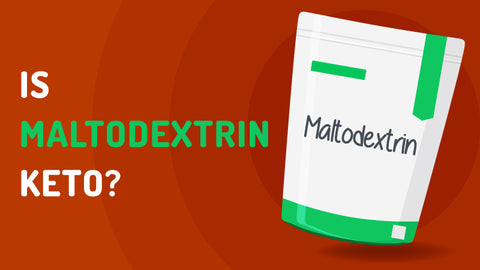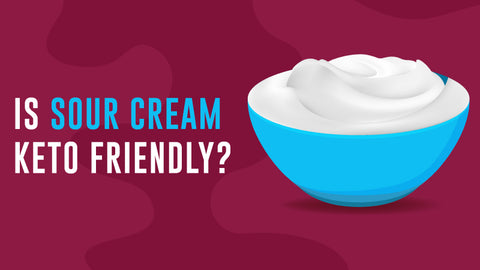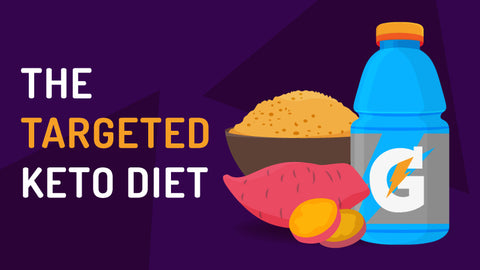The Scientific Guide to Keto

on April 10, 2019
What is the ketogenic diet?
From molecules to macronutrients, the concept of a ketogenic diet is infinitely more complicated than its low carb claim to fame. But don’t let that scare you.
In the early days, the ketogenic method primarily functioned as a way to manage certain medical disorders. Today, this high-fat, low carb revolution has helped thousands of people lose weight as it continues to evolve.
Looking to demystify and decode the ketogenic diet? Buckle in, it’s time for some science and research.
60-Second Explanation of the Keto diet
In a nutshell, the ketogenic diet is a method of attaining certain health and weight loss benefits by restricting carbohydrate intake.
By limiting the consumption of carbs, your body is able to reprogram the way it uses and stores energy. In a fascinating adaptive process, our bodies will switch energy sources — from blood sugar to stored fat — when carbohydrates become scarce.

In order to make this switch, people usually restrict their diets to 50g of carbs or less per day. After several days of extremely low carbohydrate intake, the metabolic process starts and the desired effects of accelerated weight loss, lower blood sugar levels, and more begin.
Despite going through a recent revival, the low-carb diet is anything but new. However, before we get into the roots of the ketogenic diet, one must understand the physiological mechanism behind the diet: ketosis.
What is Ketosis
To understand what ketosis is, first one must start with how the body normally breaks down the food you eat into the energy it needs.
On a typical American diet that is high in carbohydrates, most of the food you eat is broken down into the simple sugar glucose. Glucose is the body’s go-to source of energy for day to day operations and is stored in our bodies with the help of the hormone insulin.
When we eat, some of the broken down glucose goes to powering our everyday activity — moving muscles, powering cell replication, etc. When a large amount of glucose enters the blood after we eat, it triggers the production of insulin and stores the extra glucose from food into fat cells which the body can use later if needed. This is where ketosis comes in.
Ketosis, the process and central pillar of the Ketogenic diet, is a metabolic process where the body converts stored fat to ketone bodies. In the simplest of terms, ketone bodies are to fat what glucose is to carbohydrates.
Essentially, ketosis is the body’s natural response to starvation. It senses the lack of one resource and switches to another that is hopefully more widely available. This process can occur naturally in the body after long periods of strenuous exercise, during certain pregnancy conditions, and after long periods of fasting.
However, you don’t have to be starving to enter ketosis — it can also be reached by limiting carbohydrate consumption alone.
On a basic scientific level, ketosis is one of the adaptive methods human bodies use as a backup in order to stay in homeostasis. I’m sure you’ve heard it before, but it really is all about balance when it comes to nutrition.
When the body’s usual source of energy runs low, the alternate energy source it prefers comes from stored fat cells. When the body taps into these stores of fat, it converts it into those ketone bodies we discussed earlier. Ketone bodies themselves are simply a group of chemicals, specifically acetone, acetoacetate, and β-hydroxybutyric acid, which get produced in the liver. This happens when there isn’t enough insulin in your body to convert blood glucose into energy.
While achieving a state of ketosis is the ideal scenario for someone undergoing a ketogenic diet, many people who follow a keto lifestyle don’t achieve a constant state of ketosis. Fret not, though: the body will still use stored fat as an energy source even when a state of pure ketosis is not reached. If it helps, think of keto as a low-carb diet, but supercharged.
Related Conditions and Side Effects
On the standard ketogenic diet, ketosis can be achieved and maintained indefinitely. However, there are some circumstances in which the condition ketoacidosis can occur. While extremely rare outside of the diabetic community, developing metabolic acidosis is possible. Most examples of people developing ketoacidosis occur when they alter the keto diet to be more restrictive.
What happens when the body goes into ketoacidosis is the body? An excessive amount of ketones enters the blood and there is not enough insulin to store it. The excess ketone bodies alter the pH level of the blood to dangerously acidic levels.
Symptoms of Ketoacidosis include:
- Vomiting
- Frequent urination
- Extreme Thirst
- Abdominal Pain
- Breath that smells fruity
Other more common symptoms of ketosis exist as well. Keto flu may be the most notorious of them all.
What is the keto flu? It’s a group of symptoms that beginners of the keto diet experience as their bodies transition from the normal metabolic process to the ketogenic model. Symptoms may present as headache, nausea, irritability, fatigue, inability to sleep, and constipation. Together, this group of symptoms presents just like the common flu.
While much of what we know about the keto flu is anecdotal, there are a few things that can explain the symptoms one experiences. When the body transitions to a state of ketosis, it flushes a lot of water from the body, and large amounts of electrolytes along with it. Cramping, headaches, fatigue, etc. - these are all common traits of electrolyte depletion.
That being said, these symptoms do not affect everybody and each person who does experience it will experience it in a different way.
While the mechanism of ketosis has it's rooted in modern science, the early history of the ketogenic diet goes way back. Let’s take a look at the long but fascinating journey from which the modern ketogenic diet was born.
History of the Ketogenic Diet
Many people are shocked to discover that the Ketogenic Diet was not invented for weight loss. In fact, the ketogenic diet is ancient in terms of medical treatment, and as for what we today call diets, keto is one of the oldest as well. To understand how keto works today in the modern world, it is important to understand its history. It all started with studying a treatment for epilepsy using modern scientific techniques.
The 1900s and Before
In the beginning, the Ketogenic diet was developed as a treatment for epilepsy. For years, humans understood that fasting was a way to minimize the number of seizures for an epileptic. But, in 1911, early scientists from France applied the first modern scientific techniques to prove that their study participants had less severe seizures after brief periods of fasting.
1920 - 1940
The Ketogenic diet was developed shortly afterward in 1921 after discoveries by Wilder and Woodyatt. They proposed a diet high in fat and low in carbohydrates would produce similar anti-seizure effects to fasting and be easier to maintain for longer durations of time.
Word quickly spread about their findings, and soon many epileptics, especially children, were introduced to the ketogenic diet as a means of treating their seizures.
For several years, the ketogenic diet reached unprecedented levels of implementation and study. One researcher who studied over 1000 cases of epilepsy claimed that 52% of cases had full control over their seizures with another 27% obtaining improved control after implementing a ketogenic diet.
1940-1970
With the discovery of diphenylhydantoin in 1938, scientific researches turned their attention to newly formulated anti-seizure medications, which led to a decline in popularity of the ketogenic diet for epileptic treatment.
Instead of being studied extensively for a multitude of applications, the Keto diet was seen as dated technology compared to the medicinal alternative. It was soon shelved as a treatment plan with the exception of a few doctors who still prescribed the dietary plan to epileptic patients.
1970-1990
In 1971 Dr. Peter Huttenlocher introduced a medium-chain triglyceride diet in order to recapture the epileptic audience. His updated keto diet allowed fewer dietary restrictions but still failed to draw doctors or their patients away from the magic bullet of anti-seizure meds.
While interest for epileptic applications was waning, the interest in fad diets in the U.S. was growing.
Dr. Robert Atkins was one of the first to the publisher with his diet book that celebrated the concept of low carb. In the first week of his prescribed regimen, Atkins’ diet started dieters off with a week of extremely low carb, which was designed to kickstart ketosis.
Before this time, many diets were very anti-fat. The thinking was that if you ate foods high in fat, it would make you fat. However, the Atkins diet helped change this perception across America.
It’s at this junction in time where the Ketogenic diet begins its revival stage and starts to bridge the gap between medical treatment and diet craze.
The Revival of the Ketogenic Diet
In the 1970s, the low-carb diet movement was quickly gaining steam. In many ways, diets like the South Beach diet and the Atkins diet set the stage for the current keto craze.
While they were all low carb, other diet trends allowed for only moderate consumption of fats, with the primary focus being elevated levels of protein. The Ketogenic diet elevated fat to the highest levels of consumption, making up 70-80% of users’ daily calories.
While the ‘70s diet trends certainly gave the Keto diet a boost, the science behind it was the true factor in the diet’s propulsion into popular culture once again.
In 1994, NBC aired a Dateline TV special that featured Charlie, a 2-year-old who suffered from epilepsy. Charlie’s parents tried everything to help their infant son, but he still suffered from seizures, sometimes upwards of six per day.
Unresponsive to medication, Charlie was running out of treatment plans, so his parents sought out one of the few remaining physicians who was still prescribing the ketogenic diet to epileptics. Charlie was put on the Keto diet for five years and never had another seizure.
Thousands of people saw this exposé on Charlie and the ketogenic diet. It was a national news story and brought the ketogenic diet back into the spotlight.
Soon after, the amount of keto-based research skyrocketed, with doctors studying the diet in combination with dozens of other medical conditions. Most notably, dieticians started prescribing the keto diet for those looking to lose weight.
Weight loss was a known side effect of the ketogenic diet, but it took until keto’s revival to really take off with everyday people. The ketogenic diet quickly became the hottest diet trend, with influencers, celebrities, self-help gurus and podcasters all giving the diet a try and spreading their experiences online.
How It Works in 2019
Nearly one-hundred years after its inception, the Keto diet has grown and adapted with time and research. Once used only for medical treatment of epilepsy, the ketogenic diet of 2019 now spans multiple disciplines including weight loss, disease management and overall well being.
In order to enter ketosis, one must follow a certain set of rules so that the body begins the process and actively stays in ketosis.
Before we dive into the rules of the ketogenic diet, it’s important to first understand macronutrients. These are the three main nutritional categories that food gets broken down into — fats, carbohydrates, and proteins.
Because everyone is unique, the levels of these macronutrients needed can vary widely from person to person depending on a variety of factors like age, weight, activity level, and genetics.
Many newcomers to the keto diet are advised to use a keto calculator to compute their suggested daily requirements of macronutrients while on the keto diet. These calculators will tell you the exact number of grams you should be eating per day of fat, protein, and carbs.
This is a very important step to starting off keto right. Because the diet is a strict one, it can be easy to fall out of ketosis, which stalls results and causes major frustration. The margin between ketosis and non-ketosis metabolism can be very thin. One mistake or “cheat” item can throw the whole diet out of whack.
Following the rules of keto is easier said than done. Depending on your source of info, some rules of the ketogenic diet may be vague or even appear to contradict each other. However, there is a simple set of most commonly used guidelines for beginners.
Here’s a simple rundown of the diet’s rules of the road.
Basic “Rules”
The golden rule of the keto diet is to maintain a diet of less than 20-50g of carbs per day. However, diets need to be personalized in order for them to be effective. This is why when it comes to the Keto diet, no one rule is set in stone. Even the golden rule can vary depending on the individual.
At its very core, there is a defined set of basic rules that people trying the keto diet must stick to. These basic guidelines help ensure the body’s switch to ketosis is a successful one. Most definitions of keto follow these guidelines:
The following foods and behaviors are allowed on a ketogenic diet:
- Bacon, yay!
- High amounts of fat throughout the day, including each meal and snacks.
- Dairy products may be allowed, depending on the amount of lactose. Hard cheeses and butter are generally allowed. Some kinds of milk may not be allowed since they contain too many natural sugars. Instead, heavy cream may be substituted.
- Moderate amounts of protein, including grass-fed beef, free-range chicken, fish, eggs, tofu, nuts, and seeds. Natural meats like grass-fed beef and free-range chicken are preferred to grain-fed animals.
- Avocados are recommended for their healthy fat content.
- Non-starchy vegetables such as kale, bell pepper, and cauliflower.
- Extremely small portions of fruit. Berries, in particular, have a lot of fiber and are thus allowed in small quantities.
- MCT Oil, a triglyceride-heavy supplement commonly extracted from coconut oil.
The following foods and behaviors are not allowed in the ketogenic diet:
- Processed and unprocessed grains and flour products, including pasta and bread
- Natural sweeteners like sugar, molasses, honey, maple syrup or agave
- Legumes, including beans, peanuts, and lentils
- Fruits are generally not allowed because of the high amounts of natural sugar they contain. One apple may be enough carbs to knock you out of ketosis alone.
- Full-carb wine, beer, and mixed drinks

Another important concept to understand when starting the keto diet is the concept of “net carbs”. On the typical nutrition label that you’d find at a grocery store, only total carbohydrates are listed.
However, this is not the only thing keto-ers look at when determining if a food is keto-friendly or not. They also look at the grams of dietary fiber a food contains.
Dietary fiber is not digestible for energy needs, so people on the keto diet can subtract the dietary fiber from the total carbohydrates a food contains. This can transform a few non-keto friendly foods into keto-friendly friendly ones.
This is the case for many fruits, especially berries. The peels and seeds of fruits usually contain large amounts of dietary fiber if eaten in their whole form.
Erythritol and other sugar alcohols are often subtracted from net carbs as well, making them popular sweeteners for keto lifestyles.
Red Flags and Doctor Consultation
While the ketogenic diet has many research-confirmed benefits, it is not for everyone. There are some people who should never consider implementing a keto diet. Those people would include people with a history of kidney failure or kidney disease, pregnant or nursing moms, and people with previous disorders or deficiencies that can affect ketone metabolization.
Some doctors have seen an increase in kidney stones, which is often linked with a diet high in animal proteins. These painful stones are caused by calcium buildup in the kidneys.
With any major dietary change, a doctor’s consultation is recommended.
Keto Variations

Due to an increase in popularity and research, the keto diet continues to grow and change every year. As more and more people discover the keto diet, variations have been developed in order to cater to specific groups of people.
While they all split off from the original keto diet, it’s important to mark their differences, as they contribute to the pros and cons of each variation.
The “Dirty Keto” Variation
Think of the dirty keto variation of the keto diet as “the lazy man’s keto”. The dirty keto diet replaces nutritionally balanced foods within the keto spectrum with fast food.
Hamburgers sans buns are a top choice on the dirty keto diet, with many taking to Instagram to showcase their excess use of butter, bacon, and other choices high in trans and saturated fats.
Thanks to social media, many people who have heard of the keto diet mistakenly think that it gives them the liberty to eat traditional junk food as long as they technically follow the rules of keto.
Despite eating unhealthy foods, many on the dirty keto diet still lose weight. Unfortunately, the danger of this variation comes along later with increased cholesterol levels, heart disease, and other known issues of malnutrition.
Many professional nutritionists have come out as straight up against the dirty keto diet, calling it unsustainable and unhealthy.
The Cyclical Variation
If you’re looking for a more on-again, off-again relationship with the Keto diet, the cyclical variation may be the right choice for you.
In this version, keto-ers partake in the traditional keto diet for just five or six days of the week, allowing one or two days in a row for “refeeding”. During this refeeding time, cyclical keto-ers eat a higher level of carbs and exit ketosis, which essentially restores their bodies’ glucose levels before entering ketosis once more.
People who choose this variation of the ketogenic diet say the carbohydrate break makes the ketogenic diet easier for longer durations of time. Many athletes also opt into this style of keto, which allows for the occasional carb-binge before a big race or participation in endurance sports.
The High Protein Variation
This variation of the keto diet calls for a closer balance between fat and protein consumption. For the high protein version of the keto diet, 120g of protein and 130g of fat are recommended per day while keeping carb levels consistent with the original keto diet — below 10% of daily calories.
However, there are some drawbacks to this high protein version. Adding more protein back into the diet can make some people switch back out of ketosis. This is because the body has the ability to turn protein into glucose if necessary.
That being said, some people choose this high protein variation because they find the diet less restrictive and easier to stick to.
Common Keto Questions Answered with Scientific Studies

So what’s the scientific bottom line when it comes to the ketogenic diet? Some things can be confirmed with science and some rejected. There are still several things that we don’t know for sure.
Thanks to the unprecedented levels of publicity the keto diet continues to achieve, it can be difficult to decipher fact from dietary fiction.
Luckily, the ketogenic diet has inspired a second boom in research, which in turn helps thousands of people get better, safer treatment.
Here are a few frequently asked questions about the ketogenic diet and the science we use to answer them.
Does the Ketogenic diet work as a weight loss strategy?
Several studies have confirmed the Ketogenic diet as a viable weight loss method. According to a study that compared the extremely-low carb model of keto with a regular low-fat diet, the keto diet had a significantly greater amount of weight loss in addition to lower levels of blood pressure, triglycerides and cholesterol after one year.
In addition, a study from the University of Melbourne reported that levels of appetite-inducing hormones were down after test subjects implemented a keto diet.
One study from the
Is the diet safe/healthy?
Many researchers agree that the ketogenic diet itself is not dangerous. However, it can be difficult to sustain, which prompts some medical professionals to favor other dietary regimens over keto. In addition, there are conflicting studies that suggest keto may or may not be an effective tool for the long term.
The first is a study out of The Journal for Experimental and Clinical Cardiology, which showed there were beneficial effects to long-term adherence to the keto diet.
Another study from the British Medical Journal indicates that lowering your levels of dietary carbs is commensurate with an increased level of energy expenditure when maintaining weight loss. This suggests that low-carb diets like the ketogenic diet help to not only make you lose weight, but keep it off.
No matter which road you go down nutritionally, it is important to consult your doctor if you plan on making a major change in eating habits.
Can the ketogenic diet be used to treat diabetes?
Medical researcher Frederick Hecht, M.D. oversees research that is using the ketogenic diet to treat patients with type 2 diabetes. The controlled study has shown dramatic results in reducing patients’ need for medication. A study in the journal of nutrition and metabolism found that participants reached better levels of glycemic control after implementing a keto diet.
What about the ketogenic diet and inflammation?
Raymond Swanson, M.D. is a scientist-researcher studying the effects of a keto diet on mice who have had strokes. Though still in animal testing stages, the results are promising, reducing inflammation much the same way the ketogenic diet limits seizures in epileptics. More studies are needed, but researchers are hopeful that the ketogenic diet will be able to help people with chronic pain and inflammation, symptoms often associated with Alzheimer’s, Parkinson’s, and autism.
Neurological Disorders and the Keto diet
A preliminary study on rats drew promising conclusions for improving motor function for those with Parkinson’s disease. The rats who were kept on a ketogenic diet saw a significant improvement over the control group. Studies like this one are being conducted for similar neurological diseases like Alzheimer's, dementia, and more.
What We Don’t Know
Science only goes so far. Despite more and more studies being initiated every year on the topic of the ketogenic diet, there are many things we still don’t know. While burgeoning research does support several beneficial claims of the ketogenic diet, it’s important to remember that many studies are still in animal testing stages and have not been proven to work on humans.
In addition, there’s little to no scientific support for more outlandish claims of curing several types of cancer, extending life span, and improving general cognitive function.
When it comes to determining one’s reaction to the ketogenic lifestyle, everyone’s different; many people may not benefit from a strict keto diet. That said, many people report that restricting carbs has led to them feeling better, losing weight and improving their overall sense of well-being.
The only way for someone to know how their body will react to a ketogenic lifestyle is to experiment. Try it out every so often, slowly incorporating more low-carb meals into your diet, and see how you feel. There’s no need to go full keto if you’re not ready; just go as far as you feel comfortable, and see how you feel.
In Conclusion
While the ketogenic diet itself is nothing new, it is constantly being reworked and revisited. From a centuries-old treatment for epilepsy to a modern dieting trend, the keto diet covers a lot of ground. Researchers are still discovering new ways in which the diet can help people lose weight and improve their overall well-being.
Using the adaptive process of ketosis, the human body has the amazing ability to switch energy sources from glucose to ketone bodies. The discovery of this process continues to generate a lot of buzz in terms of scientific ingenuity, the human diet, and future medical treatment.
The Ketogenic diet is surrounded by science that can be confusing and reassuring at the same time. Its popularity has proliferated the low carb movement and created a unique culture of keto-ers.
With popularity comes market saturation, and more keto-branded products and services hitting the market every day. Hopefully, by understanding the mechanics of the diet from physiological historical, and pop culture perspectives, one can independently unwrap the diet itself and see it in a more approachable way.
op culture perspectives, one can independently unwrap the diet itself and see it in a more approachable way.














